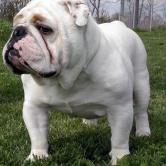Epulis and Bulldogs

You’re afraid that your Bulldog may have Epulis, but you’re not sure what this disease is all about. Let’s go over a few details that will help you understand this canine disease and will better arm you on what treatment you should undertake with your Bulldog.
First off, there hasn’t been a specific agent that can be pinpointed to cause Epulis. It is grouped into three types, based on tissue of origin:
Fibromatous Type: tumors that have a stalk or stem (pedunculated) and are non- ulcerative.
Ossifying Type: Tumors are that are pedunculated non-ulcerative.
Acanthomatous Type: This benign group of tumors are the most aggressive. They are locally invasive and its presence can result in the destruction of bone tissue.
It may surprise you to learn that some dogs only experience mild cases of Epulis and will not show any clinical manifestations. It may only be found accidentally, during a routine examination.
If you’re concerned that your Bulldog has Epulis, be on the lookout for the following symptoms:
•Facial deformities
•Bad breath (Halitosis)
•Presence of a growing mass along the periodontal tissue
•Teeth dislodgment
•Excessive salivation
•Bleeding from the gums and other parts of the mouth
•Unexplained loss of weight
•Eating difficulty (Dysphagia)
These are just common symptoms, so you’ll need to book an appointment with your vet so that can accurate diagnosis, made by using several diagnostic tests, can be performed. These tests include a Complete Blood Count (CBC), urinalysis, and biochemical profile, which are performed to establish baseline values (most results are within normal limits provided that there are no underlying causes and other ongoing disease processes).
After the CBC has been administered, your vet will conduct a thorough inspection and examination of the dog’s oral cavity. This will assess the extent of growth and destruction of oral tissues, which may include the gums and teeth. Radiographic examination of the mouth and chest, CT scans, and a biopsy of the tumor may also be suggested by your vet in order to rule out other types of oral tumors.
The best choice of treatment for Epulis may be surgery, and depending on the size and type of Epulis, the tumor will be excised or totally removed. Surgery is most commonly performed for Fibromatous Epulis and Ossifying Epulis, and may include partial mandibulectomy (removal of the lower jaw) and maxillectomy (removal of the upper jaw). If your vet determines that the Epulis are deemed inoperable, radiation therapy may be another route to take.
Once your Bulldog has completed its Epulis treatment, supportive care is an important aspect of therapy. Soft foods are often recommended to help stop or prevent tumor ulceration, and this type of diet can also be soothing after surgery.







